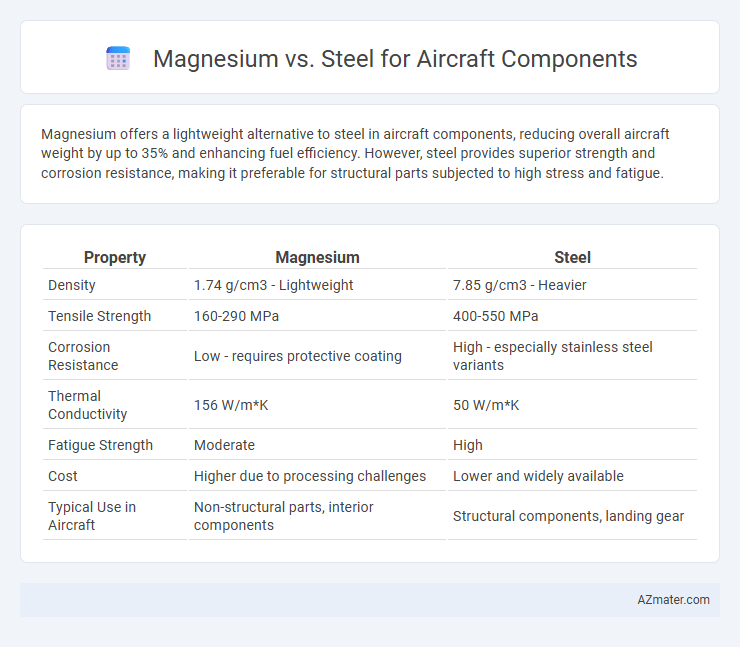Magnesium offers a lightweight alternative to steel in aircraft components, reducing overall aircraft weight by up to 35% and enhancing fuel efficiency. However, steel provides superior strength and corrosion resistance, making it preferable for structural parts subjected to high stress and fatigue.
Table of Comparison
| Property | Magnesium | Steel |
|---|---|---|
| Density | 1.74 g/cm3 - Lightweight | 7.85 g/cm3 - Heavier |
| Tensile Strength | 160-290 MPa | 400-550 MPa |
| Corrosion Resistance | Low - requires protective coating | High - especially stainless steel variants |
| Thermal Conductivity | 156 W/m*K | 50 W/m*K |
| Fatigue Strength | Moderate | High |
| Cost | Higher due to processing challenges | Lower and widely available |
| Typical Use in Aircraft | Non-structural parts, interior components | Structural components, landing gear |
Introduction to Magnesium and Steel in Aerospace
Magnesium alloys, prized for their exceptional strength-to-weight ratio, play a critical role in aerospace applications where weight reduction is paramount for fuel efficiency and performance. Steel, known for its high tensile strength and durability, is widely used in aerospace components requiring superior load-bearing capacity and resistance to fatigue and corrosion. The selection between magnesium and steel in aircraft design hinges on balancing factors such as weight constraints, mechanical properties, and environmental exposure to optimize overall aircraft safety and efficiency.
Material Properties: Magnesium vs Steel
Magnesium exhibits a high strength-to-weight ratio with a density of approximately 1.74 g/cm3, significantly lighter than steel's density around 7.85 g/cm3, making it ideal for reducing aircraft weight and improving fuel efficiency. Steel offers superior tensile strength, durability, and resistance to fatigue, with typical tensile strengths between 400-550 MPa compared to magnesium's 200-350 MPa, ensuring critical structural integrity under high stress. Corrosion resistance is a concern for magnesium due to its susceptibility to oxidation, requiring protective coatings, whereas steel alloys, especially stainless steel, provide excellent corrosion resistance essential for long-term aircraft component performance.
Weight Considerations and Impact on Aircraft Performance
Magnesium, with a density of approximately 1.74 g/cm3, is significantly lighter than steel, which has a density around 7.85 g/cm3, offering substantial weight savings for aircraft components that directly enhance fuel efficiency and payload capacity. The reduced weight of magnesium components lowers the overall aircraft mass, improving climb rates, range, and maneuverability compared to steel parts. However, the trade-offs include magnesium's lower strength and corrosion resistance, which require careful design and protective coatings to maintain performance and safety standards in aerospace applications.
Strength and Durability Comparison
Magnesium alloys offer a lightweight advantage over steel, making them ideal for reducing overall aircraft weight and improving fuel efficiency. However, steel exhibits superior tensile strength and corrosion resistance, contributing to greater durability in high-stress aircraft components. Advanced coatings and treatments can enhance magnesium's durability, but steel remains the preferred choice for critical load-bearing parts requiring long-term reliability.
Corrosion Resistance in Aviation Environments
Magnesium alloys, known for their lightweight properties, exhibit lower corrosion resistance compared to steel when exposed to aviation environments characterized by moisture, salt, and temperature fluctuations. Steel components offer superior corrosion resistance due to their chromium content and protective oxide layers, making them more durable for critical aircraft structures exposed to harsh conditions. Protective coatings and treatments are essential for magnesium to enhance its corrosion resistance in aerospace applications and prevent premature material degradation.
Manufacturing and Machinability Differences
Magnesium offers superior machinability compared to steel, with lower cutting forces and faster material removal rates, reducing manufacturing time and tool wear in aircraft component production. Steel, while stronger and more durable under high-stress conditions, requires more precise machining parameters and often necessitates additional heat treatment processes. The lightweight nature of magnesium contributes to significant weight savings in aircraft design, but its lower melting point and susceptibility to corrosion demand specialized manufacturing techniques such as protective coatings and controlled environments.
Cost Analysis: Magnesium vs Steel Components
Magnesium components in aircraft offer significant cost advantages over steel due to their lower material density, which reduces weight and fuel consumption during operation, leading to long-term savings. Magnesium's machining and manufacturing costs can be higher than steel, but these are often offset by improved lifecycle efficiency and reduced maintenance expenses. Overall, the trade-off between initial production costs and operational cost savings makes magnesium a cost-effective choice for weight-critical aircraft parts compared to traditional steel components.
Safety Concerns and Fire Risk Assessment
Magnesium, valued for its lightweight properties, poses significant fire risks due to its high flammability and intense burning temperatures, requiring stringent fire suppression systems in aircraft components. Steel, while heavier, offers superior strength and lower combustibility, enhancing overall structural safety and reducing fire hazard potential in critical aircraft parts. Safety assessments favor steel for components where fire resistance outweighs weight savings, highlighting the importance of material selection in managing aircraft fire risk.
Environmental Impact and Recyclability
Magnesium offers a lower carbon footprint compared to steel due to its lighter weight, which reduces fuel consumption and emissions in aircraft operations. Steel is highly recyclable with well-established recycling infrastructure, ensuring minimal environmental waste, while magnesium recycling is less developed but improving. Both materials present environmental trade-offs, with magnesium providing operational efficiency benefits and steel excelling in circular lifecycle management.
Future Trends in Aircraft Material Selection
Magnesium alloys, favored for their lightweight properties and excellent strength-to-weight ratio, are increasingly considered alongside traditional steel in aircraft component manufacturing to enhance fuel efficiency and reduce emissions. Advances in corrosion resistance and alloy stabilization are driving broader adoption of magnesium, while steel remains essential for high-stress, load-bearing parts due to its superior durability and fatigue resistance. Future aircraft material selection trends emphasize hybrid structures combining magnesium's lightness with steel's strength, supported by developments in additive manufacturing and surface treatments that optimize performance and sustainability.

Infographic: Magnesium vs Steel for Aircraft Component
 azmater.com
azmater.com